https://www.angelfire.com/electronic/planetarycom/robot.html
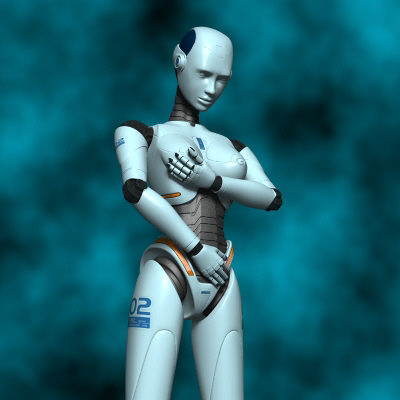 This site is devoted to androids. An android is an anthropomorphic robot - i.e. a robot that looks like a human. Many android developers call their creations "humanoids" rather than androids.
This site is devoted to androids. An android is an anthropomorphic robot - i.e. a robot that looks like a human. Many android developers call their creations "humanoids" rather than androids.
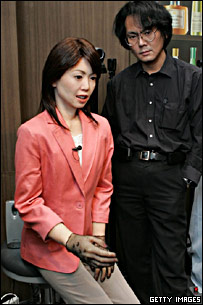
Professor Ishiguro (r) stresses the importance of appearance in his robots
Japanese scientists have unveiled the most human-looking robot yet - a "female" android named Repliee Q1Expo.
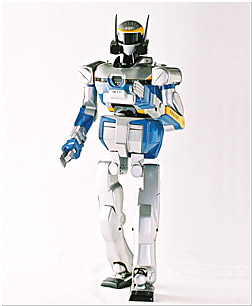 HRP-2 is the final robotic platform for the Humanoid Robotics Project headed by the Manufacturing Science and Technology Center (MSTC), which are sponsored by the Ministry of Economy, Trade and Industry (METI) through New Energy and Industrial Technology Development Organization (NEDO).
The total robotic system was designed and integrated by Kawada Industries, Inc. together with Humanoid Research Group of National Institute of Advanced Industrial Science and Technology (AIST). Yasukawa Electric Corporation provided the initial concept design for the arms and AIST 3D Vision Research Group and Shimizu Corporation provided the vision system.
HRP-2 is the final robotic platform for the Humanoid Robotics Project headed by the Manufacturing Science and Technology Center (MSTC), which are sponsored by the Ministry of Economy, Trade and Industry (METI) through New Energy and Industrial Technology Development Organization (NEDO).
The total robotic system was designed and integrated by Kawada Industries, Inc. together with Humanoid Research Group of National Institute of Advanced Industrial Science and Technology (AIST). Yasukawa Electric Corporation provided the initial concept design for the arms and AIST 3D Vision Research Group and Shimizu Corporation provided the vision system.
Tokyo, Japan - Sony Corporation today announced the development of a prototype small biped entertainment robot "SDR-4X" that can adapt its performance to its environment and situations found in the home to further develop the possibility for a biped-walking robot. Richer communication with people can be realized by a variety of sensor systems, performance control software based on memory and learning, and a flexible biped walking mechanism.
Waseda University has been one of the leading research sites for anthropomorphic robots since the late Prof. Ichiro Kato and his colleagues started the WABOT Project in 1970. Since then, just about ten years, by integrating the latest key technologies, we have developed a variety of humanoid robots including WABOT-1 which is the first full-scale human-like robot made in 1973, the musician robot WABOT-2 in 1984, Hadaly-2 which works together with a human partner and the biped walking robot WABIAN in 1997. Not only a lot of fundamental technology was created but also the many talented engineers and scientists were nurtured from these activities.
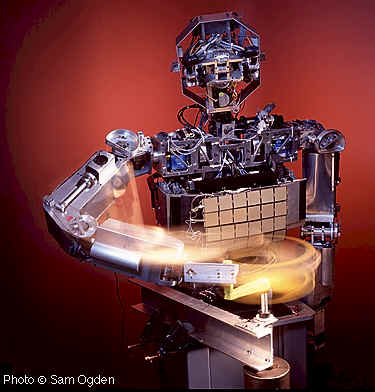 Avoiding flighty anthropomorphism, you can consider Cog to be a set of sensors and actuators which tries to approximate the sensory and motor dynamics of a human body. Except for legs and a flexible spine, the major degrees of motor freedom in the trunk, head, and arms are all there. Sight exists, in the form of video cameras. Hearing and touch are on the drawing board. Proprioception in the form of joint position and torque is already in place; a vestibular system is on the way. Hands are being built as you read this, and a system for vocalization is also in the works. Cog is a single hardware platform which seeks to bring together each of the many subfields of Artificial Intelligence into one unified, coherent, functional whole.
Avoiding flighty anthropomorphism, you can consider Cog to be a set of sensors and actuators which tries to approximate the sensory and motor dynamics of a human body. Except for legs and a flexible spine, the major degrees of motor freedom in the trunk, head, and arms are all there. Sight exists, in the form of video cameras. Hearing and touch are on the drawing board. Proprioception in the form of joint position and torque is already in place; a vestibular system is on the way. Hands are being built as you read this, and a system for vocalization is also in the works. Cog is a single hardware platform which seeks to bring together each of the many subfields of Artificial Intelligence into one unified, coherent, functional whole.
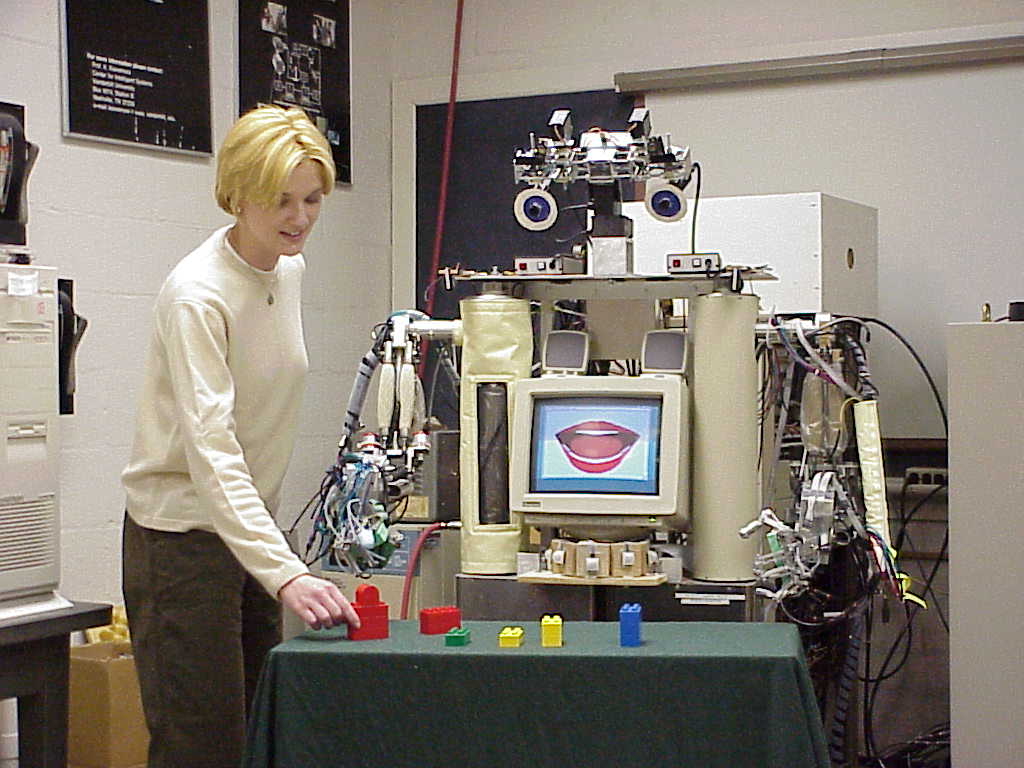
Although robots seem to possess fantastic skills in science fiction movies, it would surprise many people to learn howmuch still needs to be done to endow today' s service robots with the ability to do relatively simple tasks. One of the most challenging problems is that of giving the robot an understanding of how to interact with human beings. The interaction between two people is natural since they understand each other, in contrast to the interaction between a robot and a person. One research focus of the Center for intelligent Systems' laboratories is on the development of improved human-robot interaction (HRI) techniques, both for sophisticated humanoid robots as well as for mobile robots.
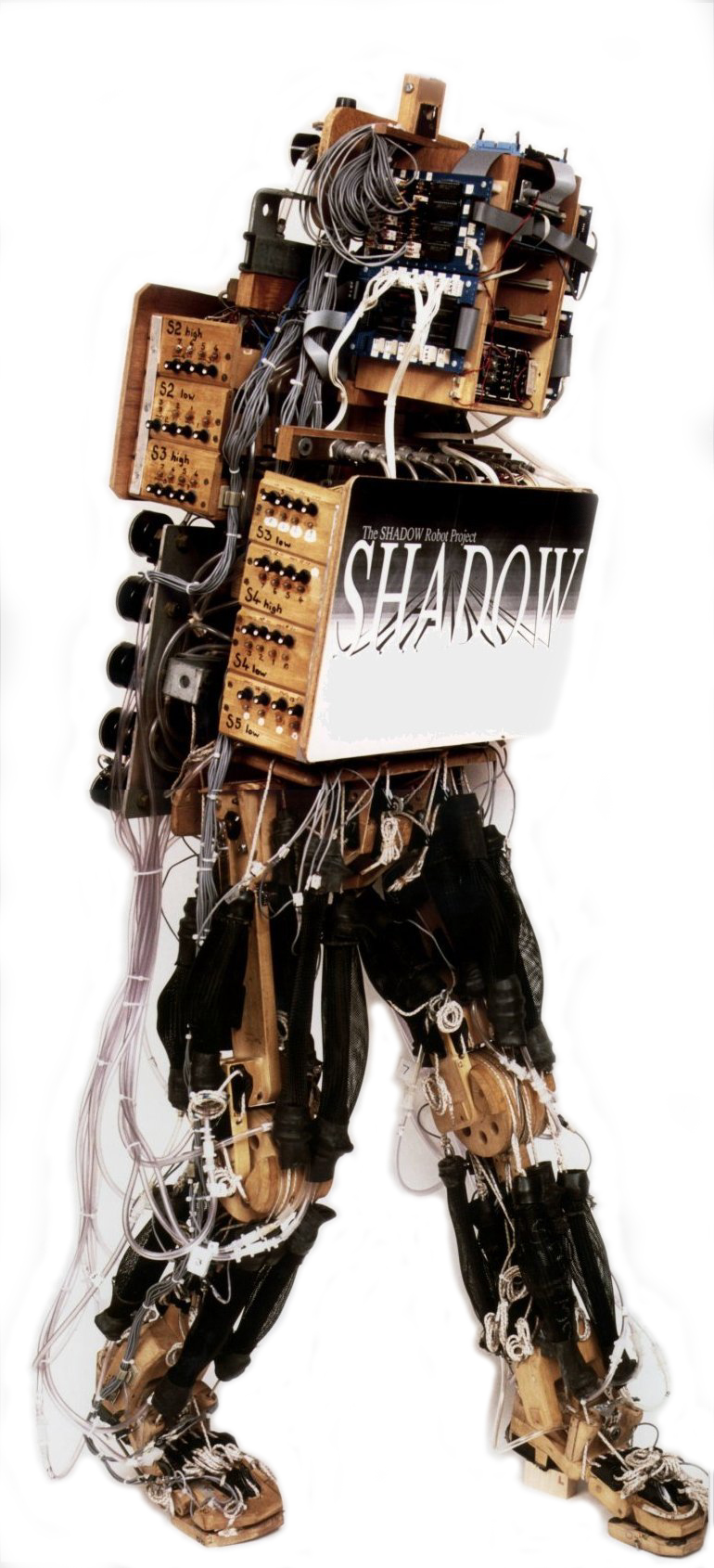
The Shadow Robot uses a wooden skeletal frame on which the muscles and equipment are mounted. In the early stages of development using wood proved to be cost effective and very strong. Maple proved to be the ideal choice because of its fine consistency, which is easily machined. 
It is possible to build a computer-driven, life-size, android robot head (Figure 1) for cost of materials of about $600.00. The android head will have two color video-camera eyes with the video going both into a window on the PC and into an image processing Java application. The robot will have six servo motors controlling: (1) base of the head spins, (2,3) each eye moves left/right, (4) both eyes move up/down, (5,6) each eye-lid opens/closes. All servo motors are controlled via a Perl/Tk application. The user supplies the computer (PC). The details of how to construct such a head follows, based on the authors creation of Robot Maxamilian, R. Max for short.
This list of fictional robots and androids is a chronological list, categorised by medium. It includes all depictions of robots, androids and gynoids in literature, television, and cinema; however, robots that have appeared in more than one form of media are not necessarily listed in each of those media. This list is intended for all fictional computers which are described as existing in a humanlike or mobile form. It shows how the concept has developed in the human imagination through history.
A control system can be thought of as a vast autonomous robot that can be overridden to varying degrees by human operators. But they are designed such that they respond correctly (hopefully) without human intervention. The system must do the right thing when shit strikes fans (loss of inputs and outputs, fires, chemical explosions, nuclear melt-down, that kind of thing) even when information is incomplete and the exact nature of the failure is unanticipated by the programmers. The interesting thing about control systems is that they are too complex to be understood in their entirety, firstly because their environment can never be completely modeled and secondly because of the staggering number of possible interactions between the many lines of software code and hardware components. These systems need to be autonomous and have always been designed that way from the ground up: they are immobots and they are doing much of the work that people used to do, and more.
Android Technologies, Inc.
Android Technologies, Inc. is a high tech company that offers algorithmic development on a contract basis. With experience in A.I. technologies such as Genetic Algorithms, Neural Networks, Data Mining, Adaptive Virtual Personalities, and Speech recognition, we can help your company pursue itsí A.I. goals at a reasonable cost.
We can also provide high level consulting and decision assistance in structuring and managing your virtual reality online community and supporting avatar enhancement code.
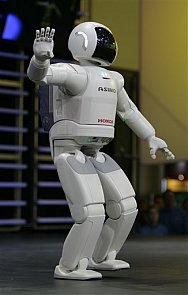
Join the A. L. I. C. E. Artificial Intelligence Foundation

Defense Conversion on a Budget
Space craft hardware we converted into useful items.
Robots
Rock and Roll Equipment
Money and later our Flying Saucer
 This site is devoted to androids. An android is an anthropomorphic robot - i.e. a robot that looks like a human. Many android developers call their creations "humanoids" rather than androids.
This site is devoted to androids. An android is an anthropomorphic robot - i.e. a robot that looks like a human. Many android developers call their creations "humanoids" rather than androids. 
